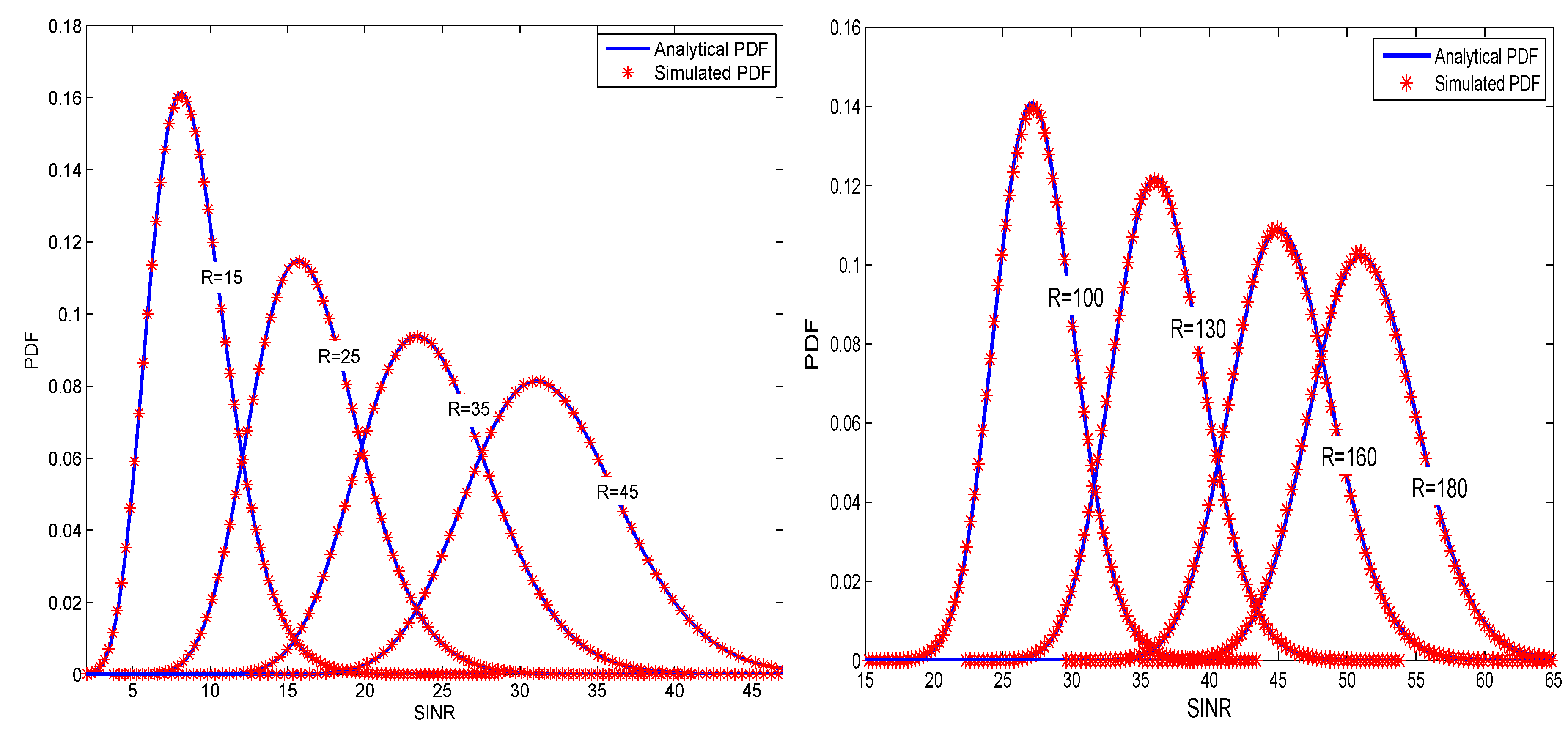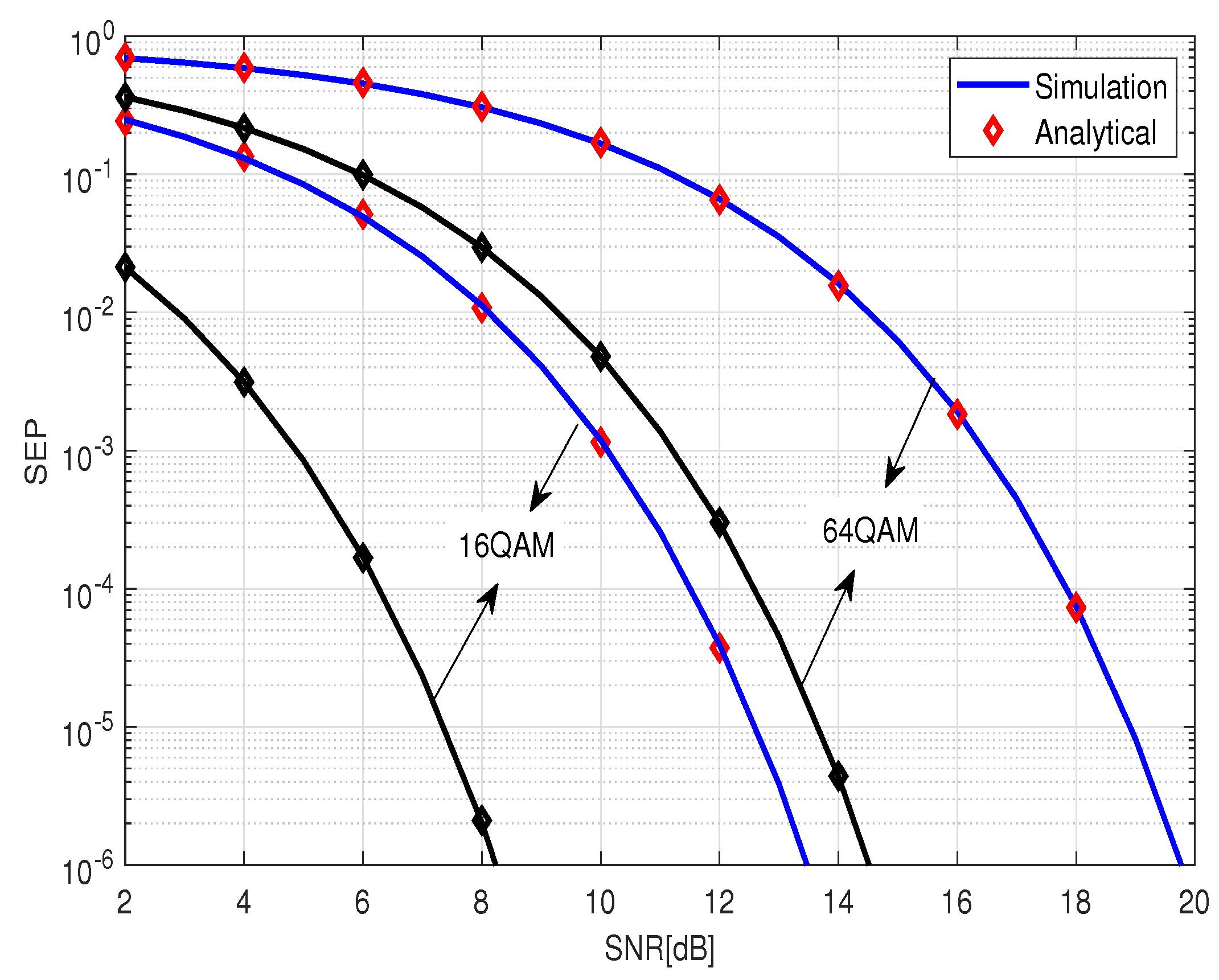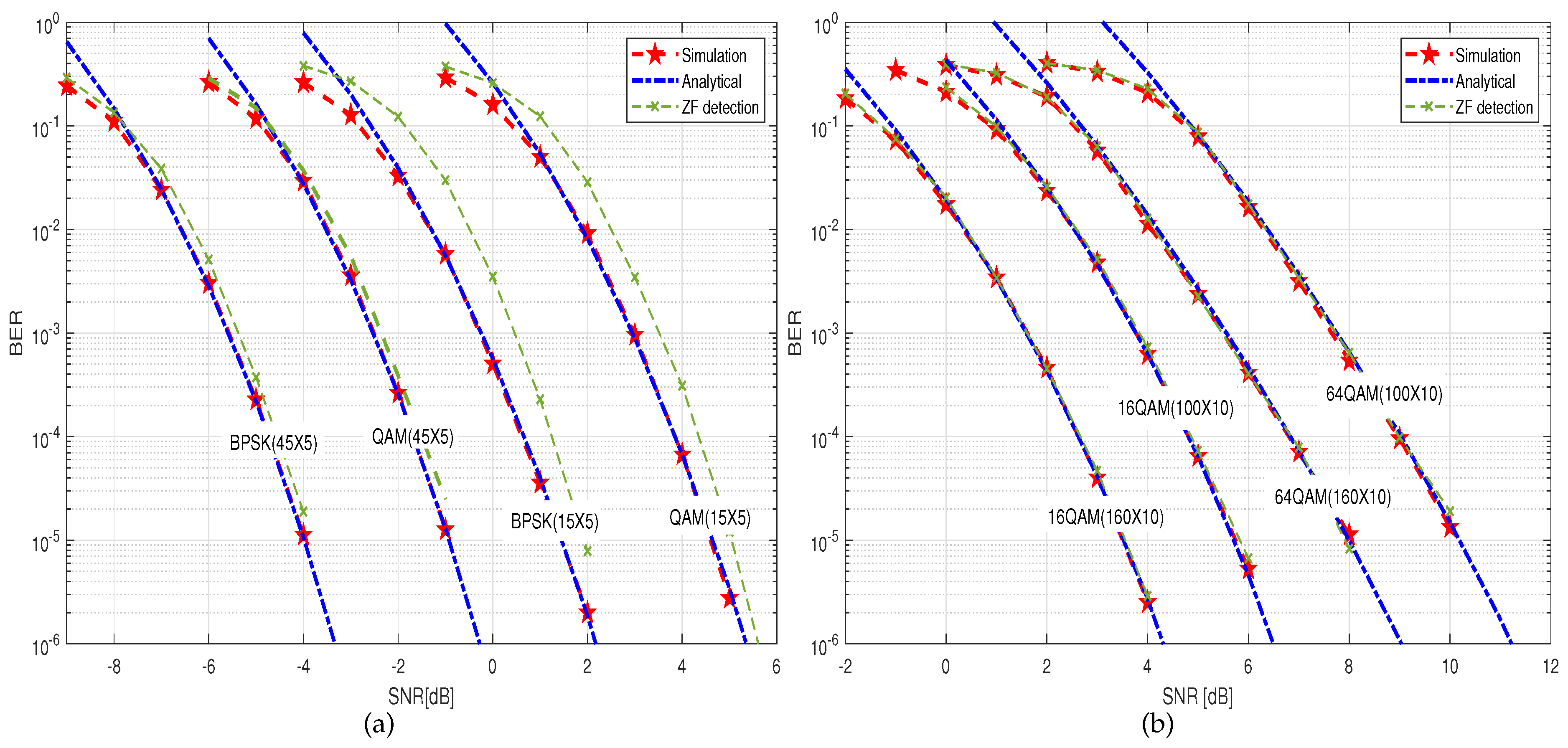Accurate Performance Analysis of Coded Large-Scale Multiuser MIMO Systems with MMSE Receivers
Abstract
1. Introduction
- We derive a novel statistical distribution of the SINR for any user when the channels are subject to path loss, shadowing and Rayleigh fading.
- Using the derived SINR density, we further derive the PEP, which is then used to obtain analytical expressions relating to upper-bounds on BER of the convolutionally coded massive multiuser MMSE–MIMO systems.
2. System Model
3. Distribution of the SINR
4. Performance Analysis of Coded Multiuser MIMO System with an MMSE Detector
4.1. BER Upper Bound in Both Small- and Large-Scale Fading
4.2. Asymptotical Diversity Order
5. Numerical Results and Simulations
6. Conclusions
Author Contributions
Funding
Conflicts of Interest
References
- Andrews, J.G.; Buzzi, S.; Choi, W.; Hanly, S.V.; Lozano, A.; Soong, A.C.K.; Zhang, J.C. What will 5G be? IEEE J. Sel. Areas Commun. 2014, 32, 1065–1082. [Google Scholar] [CrossRef]
- Naeem, M.; Bashir, S.; Ullah, Z.; Syed, A.A. A Near Optimal Scheduling Algorithm for Efficient Radio Resource Management in Multi-user MIMO Systems. Wirel. Pers. Commun. 2019, 1–17. [Google Scholar] [CrossRef]
- Tseng, S.M.; Chen, Y.F. Average PSNR optimized cross layer user grouping and resource allocation for uplink MU-MIMO OFDMA video communications. IEEE Access 2018, 6, 50559–50571. [Google Scholar] [CrossRef]
- Vanidevi, M.; Selvaganesan, N. Fast iterative WSVT algorithm in WNN minimization problem for multiuser massive MIMO channel estimation. Int. J. Commun. Syst. 2018, 31, E3378. [Google Scholar] [CrossRef]
- Rusek, F.; Persson, D.; Lau, B.K.; Larsson, E.G.; Marzetta, T.L.; Edfors, O.; Tufvesson, F. Scaling up MIMO: Opportunities and challenges with very large arrays. IEEE Signal Process. Mag. 2013, 30, 40–60. [Google Scholar] [CrossRef]
- Hassan, A.K.; Moinuddin, M.; Al-Saggaf, U.M. Sum Ergodic Capacity Analysis Using Asymptotic Design of Massive MU-MIMO Systems. Wirel. Pers. Commun. 2018, 100, 1743–1752. [Google Scholar] [CrossRef]
- Senanayake, R.; Smith, P.; Yeoh, P.L.; Evans, J. An SNR approximation for distributed massive MIMO with zero forcing. IEEE Commun. Lett. 2015, 19, 1885–1888. [Google Scholar] [CrossRef]
- Wang, B.; Chang, Y.; Yang, D. On the SINR in massive MIMO networks with MMSE receivers. IEEE Commun. Lett. 2014, 18, 1979–1982. [Google Scholar] [CrossRef]
- AI-Askery, A.J.A.; Tsimenidis, C.C.; Boussakta, S.; Chambers, J.A. Performance Analysis of Coded Massive MIMO-OFDM Systems Using Effective Matrix Inversion. IEEE Trans. Commun. 2017, 65, 5244–5256. [Google Scholar] [CrossRef]
- Ngo, H.Q.; Larsson, E.G.; Marzetta, T.L. Energy and Spectral Efficiency of Very Large Multiuser MIMO systems. IEEE Trans. Commun. 2013, 61, 1436–1449. [Google Scholar] [CrossRef]
- Li, P.; Paul, D.; Narasimhan, R.; Cioffi, J. On the distribution of SINR for the MMSE–MIMO receiver and performance analysis. IEEE Trans. Inf. Theory 2006, 52, 271–286. [Google Scholar] [CrossRef]
- Gao, H.; Smith, P.J.; Clark, M.V. Theoretical reliability of MMSE linear diversity combining in Rayleigh-Fading additive interference channels. IEEE Trans. Commun. 1998, 46, 666–672. [Google Scholar] [CrossRef]
- Kim, N.; Park, H. Bit error performance of convolutional coded MIMO system with linear MMSE receiver. IEEE Trans. Wirel. Commun. 2009, 8, 3420–3424. [Google Scholar] [CrossRef]
- Fu, Y.; Zhang, W.; Xia, X. Uplink Performance Analysis of Mixed-ADC Massive MIMO Systems with MMSE Receivers. In Proceedings of the 10th International Conference on Wireless Communications and Signal Processing (WCSP), IEEE, Hangzhou, China, 18–20 October 2018. [Google Scholar]
- Bj<i>o</i>¨rnson, E.; Sanguinetti, L. Making Cell-Free Massive MIMO Competitive With MMSE Processing and Centralized Implementation. arXiv 2019, arXiv:1903.10611. [Google Scholar]
- Zhai, K.; Ma, Z.; Lei, X. Distribution for the SINR and Performance Analysis of MMSE-Detected MIMO Systems. AEU-Int. J. Electron. Commun. 2018, 97, 16–24. [Google Scholar] [CrossRef]
- Hien, N.Q.; Matthaiou, M.; Duong, T.; Larsson, E. Uplink performance analysis of multicell MU-SIMO systems with ZF receivers. IEEE Trans. Veh. Technol. 2013, 62, 4471–4483. [Google Scholar] [CrossRef]
- Kim, N.; Lee, Y.; Park, H. Performance analysis of MIMO system with linear MMSE receiver. IEEE Trans. Wirel. Commun. 2008, 7, 4474–4478. [Google Scholar] [CrossRef]
- Kim, W.; Kim, N.; Chung, H.K.; Lee, H. SINR distribution for MIMO MMSE receivers in transmit-correlated Rayleigh channels: SER performance and high-SNR power allocation. IEEE Trans. Veh. Technol. 2013, 62, 4083–4087. [Google Scholar] [CrossRef]
- Bai, Z.D.; Silverstein, J.W. Spectral Analysis of Large-Dimensional Random Matrices, 2nd ed.; Springer: New York, NY, USA, 2010. [Google Scholar]
- Alfano, G.; Lozano, A.; Tulino, A.M.; Verdu´, S.V. Capacity of MIMO channels with one-sided correlation. In Proceedings of the Eighth IEEE International Symposium on Spread Spectrum Techniques and Applications-Programme and Book of Abstracts (IEEE Cat. No.04TH8738), Sydney, Australia, 30 August–2 September 2004. [Google Scholar] [CrossRef]
- Gradshteyn, I.S.; Ryzhik, I.M. Table of Integrals, Series, and Products, 7th ed.; Elsevier: Amsterdam, The Netherlands, 2007. [Google Scholar]
- Tulino, A.M.; Verdu´, S. Random Matrix Theory and Wireless Communications. Found. Trends Commun. Inf. Theory 2004, 1, 1–182. [Google Scholar] [CrossRef]
- Bao, J.; Ma, Z.; Karagiannidis, G.K.; Xiao, M.; Zhu, Z. Joint multiuser detection of multidimensional constellations over fading channels. IEEE Trans. Commun. 2017, 65, 161–172. [Google Scholar] [CrossRef]
- Tran, N.H.; Nguyen, H.H.; Le-Ngoc, T. Performance of BICM-ID with signal space diversity. IEEE Trans. Wirel. Commun. 2007, 6, 1732–1742. [Google Scholar] [CrossRef]



© 2019 by the authors. Licensee MDPI, Basel, Switzerland. This article is an open access article distributed under the terms and conditions of the Creative Commons Attribution (CC BY) license (http://creativecommons.org/licenses/by/4.0/).
Share and Cite
Zhai, K.; Ma, Z.; Lei, X. Accurate Performance Analysis of Coded Large-Scale Multiuser MIMO Systems with MMSE Receivers. Sensors 2019, 19, 2884. https://doi.org/10.3390/s19132884
Zhai K, Ma Z, Lei X. Accurate Performance Analysis of Coded Large-Scale Multiuser MIMO Systems with MMSE Receivers. Sensors. 2019; 19(13):2884. https://doi.org/10.3390/s19132884
Chicago/Turabian StyleZhai, Kai, Zheng Ma, and Xianfu Lei. 2019. "Accurate Performance Analysis of Coded Large-Scale Multiuser MIMO Systems with MMSE Receivers" Sensors 19, no. 13: 2884. https://doi.org/10.3390/s19132884
APA StyleZhai, K., Ma, Z., & Lei, X. (2019). Accurate Performance Analysis of Coded Large-Scale Multiuser MIMO Systems with MMSE Receivers. Sensors, 19(13), 2884. https://doi.org/10.3390/s19132884



